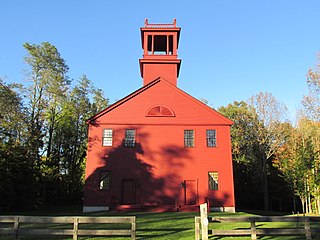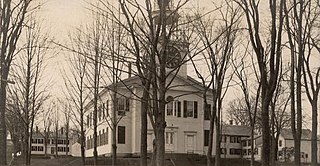
Kate Douglas Wiggin was an American educator, author and composer. She wrote children's stories, most notably the classic children's novel Rebecca of Sunnybrook Farm, and composed collections of children's songs. She started the first free kindergarten in San Francisco in 1878. With her sister during the 1880s, she also established a training school for kindergarten teachers. Kate Wiggin devoted her adult life to the welfare of children in an era when children were commonly thought of as cheap labor.

Blooming Grove United Church of Christ, also known just as Blooming Grove Church and formerly known as The Congregational Church of Blooming Grove, is located at the junction of Old Dominion Road and NY 94 in the town of Blooming Grove, between the villages of Chester and Washingtonville in Orange County, New York, United States. It is a plain white Federal style building, notable for lacking the steeple or cupola commonly found on churches.

The Rockingham Meeting House, also known as Old North Meeting House and First Church in Rockingham, is a historic civic and religious building on Meeting House Road in Rockingham, Vermont, United States. The Meeting House was built between 1787 and 1801 and was originally used for both Congregational church meetings as well as civic and governmental meetings. Church services ceased in 1839 but town meetings continued to be held in it until 1869. It was designated a National Historic Landmark in 2000 as an exceptionally well-preserved "second period" colonial-style meeting house. The building, owned by the town, is available for weddings and other events under rules established by the town.

The First Congregational Church of Bennington, also known as the Old First Church, is a historic church in Old Bennington, Vermont. The congregation was organized in 1762 and the current meeting house was built in 1805. The building, one of the state's best examples of Federal period religious architecture, was added to the National Register of Historic Places in 1973.

The Universalist Society Meetinghouse is an historic Greek Revival meetinghouse at 3 River Road in Orleans, Massachusetts. Built in 1834, it was the only Universalist church built in Orleans, and is architecturally a well-preserved local example of Greek Revival architecture. The Meeting House is now the home of the Orleans Historical Society and is known as the Meeting House Museum. It was listed on the National Register of Historic Places in 1999.

The Evangelical Lutheran Church of St. Peter, known locally as the Old Stone Church, is located on US 9 in the Town of Rhinebeck, New York, United States. It is a stone church built in the late 18th century by the area's Palatine German immigrant population. It has been renovated significantly since then. The church congregation was established in 1729.

The Cotton Mountain Community Church, also known as the Wolfeborough, Brookfield and Wakefield Meetinghouse, is a historic church on Stoneham Road in Wolfeboro, New Hampshire, near the town line with Brookfield. Built about 1852, it is a well-preserved example of a rural New England meeting house with vernacular Greek Revival style. The building was listed on the National Register of Historic Places in 1985. Since 1957, when it stopped being used for services, it has been cared for by a local nonprofit group.

The White Meetinghouse, also known as the First Freewill Baptist Society Meetinghouse, is a historic meeting house on Towle Hill Road, south of Eaton Center, New Hampshire. Built in 1844, it is a well-preserved and little-altered example of a vernacular Greek Revival meeting house. The building was listed on the National Register of Historic Places in 1980. The building is now maintained by a local community organization, and is used for community events and occasional services.

The First Baptist Church, also known as the Old Corner Church, is a historic church at West and Federal Streets in Waterboro, Maine. Built in 1803-04 and altered to a Greek Revival appearance in 1849, it retains significant characteristics of more traditional Federal period meetinghouses. The building was listed on the National Register of Historic Places in 1988.

The First Parish Meetinghouse, also known as the Old Red Church, is a historic church building on Oak Hill Road in Standish, Maine. Built 1804-06, it is a well-preserved example of rural Federal period design. The building has served the community as a church and school, and is still occasionally used for religious services. It was listed on the National Register of Historic Places in 1975.

The Elijah Kellogg Church is a historic Congregationalist church at 917 Harpswell Neck Road in Harpswell, Maine. Built in 1843, it is a well-preserved example of Greek and Gothic Revival architecture, and is further notable for its longtime association with Rev. Elijah Kellogg, a well-known 19th-century writer of children's books. The church building was listed on the National Register of Historic Places in 1979. The church is affiliated with the National Association of Congregational Christian Churches; its pastor is John Carson.

The Elm Street Congregational Church and Parish House is a historic church complex at Elm and Franklin Streets in Bucksport, Maine. It includes a Greek Revival church building, built in 1838 to a design by Benjamin S. Deane, and an 1867 Second Empire parish house. The church congregation was founded in 1803; its present pastor is the Rev. Stephen York. The church and parish house were listed on the National Register of Historic Places in 1990. It is a congregational member of the United Church of Christ.

St. John's Episcopal Church is a historic church on the south side of Maine State Route 27 at Blinn Hill Road in Dresden Mills, Maine. Built in 1832, it is a distinctive architectural blend of Federal, Greek Revival and Gothic Revival styling. It was listed on the National Register of Historic Places in 1991.

The Walpole Meetinghouse is a historic church on Walpole Meeting House Road in the Walpole area of South Bristol, Maine. Built in 1772, it is a well-preserved and little-altered example of a late colonial church in coastal Maine, and one of the oldest actively used churches in the state. It was listed on the National Register of Historic Places in 1976. It is maintained by a non-profit organization, and is still used occasionally for summer services.

The First Church of Belfast is a historic church at 8 Court Street in Belfast, Maine. The church congregation was founded in 1796, and its present building was built in 1818. The well-preserved Federal style church was listed on the National Register of Historic Places in 1976, as one of a few churches in the state based closely on the designs of Asher Benjamin. The congregation is affiliated with the United Church of Christ; its current pastors are Dr. Kate Winters and Rev. Joel Kruger.

The Mercer Union Meetinghouse is a historic church in Mercer, Maine. Built in 1829 for several different denominations to share, this church is a relatively early and rare example of transitional Federal-Gothic styling in the state, with its tower set partially over the entrance vestibule, another uncommon feature. The building was listed on the National Register of Historic Places in 2007.

The Proprietors Meeting House and Parish House, known for many years as the Universalist Church of Scarborough and South Buxton, is a historic church complex at the junction of Maine State Route 22 and Old County Road in the village of South Buxton, on the Scarborough side of the town line with Buxton, Maine. The church, built about 1839, is a fine local example of transitional Federal-Gothic Revival architecture, and the adjacent parish house, built in 1914, is a good local example of the Bungalow style. The property, purchased for use of the Maine Hindu Temple in 2012, was listed on the National Register of Historic Places in 2001.

The Grand Isle United Methodist Church, formerly the Congregational Church—Grand Isle, is a historic church in Grand Isle, Vermont. Built in 1853-54, it is a well-preserved local example of Greek Revival architecture, and the town's oldest surviving church building. Originally built for a Congregationalist group, it is now home to a United Methodist Church congregation. The church was listed on the National Register of Historic Places in 2001.

The Post Mills Church is a historic church at 449 Vermont Route 244 in the Post Mills village of Thetford, Vermont. Built in 1818 and remodeled in 1855, it is an excellent example of Greek Revival architecture, with extremely rare late 19th century stencilwork on its interior walls and ceiling. It was listed on the National Register of Historic Places in 1992. The congregation is affiliated with the United Church of Christ.

The Robinhood Free Meetinghouse is a historic church building at 210 Robinhood Road in Georgetown, Maine. Built in 1856, it is a modest example of vernacular Greek Revival architecture, distinctive as one of Maine's few rural 19th-century churches to have its sanctuary space on the second floor. The building was listed on the National Register of Historic Places in 2016; it has recently been converted for use as a restaurant.






















